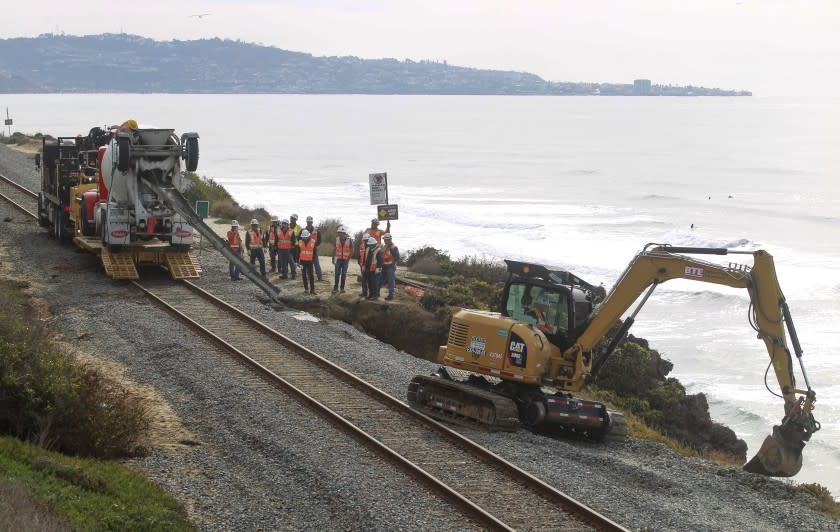California opposes district's bid to control Del Mar bluffs, erect chain-link fence

The California Coastal Commission has asked the North County Transit District to withdraw its request for sole control over projects to stabilize the railroad tracks on the coastal bluffs in Del Mar in San Diego County.
The transit district filed a petition in August with the federal Surface Transportation Board asking it to relieve the Coastal Commission and the city of Del Mar of jurisdiction over the bluff projects, including plans to install a chain-link fence that would stop pedestrians from crossing the tracks to get to the beach.
“Along with many members of the public, I was shocked and dismayed by North County Transit District’s (NCTD) abrupt decision to not only end its collaboration with the Coastal Commission staff ... but to do so without any notice or warning,” said the Oct. 15 letter from commission Executive Director John Ainsworth.
The commission has worked with the transit agency and its partner the San Diego Assn. of Governments on at least 28 railroad projects since 2002, Ainsworth said. Those include adding segments of double track, replacing old bridges and trestles, and previous bluff stabilization projects.
“We believe that these final projects were better for the public and the environment through the efforts of NCTD, SANDAG and the commission to collaborate through the planning and approval process,” he said.
Transit district officials, in their petition to the Surface Transportation Board, said one of the reasons they need the waiver is because the Del Mar City Council, in an April 21 letter to the Coastal Commission, requested “far-reaching, unduly burdensome mitigation measures” for emergency repairs made after a Thanksgiving weekend storm eroded the bluffs last year.
The city’s requested mitigation included that the transit agency be required to cover the bluff repairs with natural soil and native plantings instead of the shotcrete wall that was installed. The city also proposed “a laundry list of mitigation requirements for future bluffs projects,” the petition states.
Del Mar council members, at a recent meeting, said they were surprised by the North County Transit District petition and that they did not expect such a negative reaction to their letter.
“It’s essential to fight this as a team so we have access to the beach and bluffs,” said Councilman Dave Druker.
Del Mar city officials and a representative of the nonprofit Surfrider Foundation have written letters opposing the petition. Amtrak and the Assn. of American Railroads reportedly have announced support.
Del Mar residents have long opposed the construction of a fence along the railroad. Many people feel they have the right to walk along the tracks or cross the tracks wherever they want. Some are coastal homeowners who say a fence would ruin their ocean view.
Though the Surface Transportation Board has not yet decided the petition, North County Transit District officials said recently they have the right to install the 6-foot-tall fence along with lights, security cameras and public-address speakers within the railroad right-of-way without additional approvals. The district plans to complete the project by the end of this year.
“It is critical that we take all necessary actions to support the safe and efficient movement of passenger and freight trains while striving to keep the public safe,” transit district marketing and communications manager Kimy Wall said recently in an emailed response to questions.
In addition to plans to increase the number of trains, the transit district recently purchased new locomotives that are faster and quieter than the ones now operating. The new engines are expected to enter service early next year. Also, because of their speed and weight, the trains may need more than a half-mile to stop in an emergency.
The transit district recently released the results of a study of San Diego County’s coastal railroad corridor that identified areas in three cities — Oceanside, Encinitas and Del Mar — where the fence is most needed because people frequently trespass on the tracks.
The report identifies the number of trespasser “strikes” from 2015-19, but does not distinguish between suicides, accidental deaths or injuries, though the majority of strikes are suicides.
Oceanside had 10 trespasser strikes on the tracks from the transit center to the Carlsbad border, the study showed. Most of the hits were in the northern half of the segment, where people cross to get to the beach neighborhoods.
Encinitas had 11 strikes within 2.5 miles, the longest of the three rail segments. Most of those incidents were also in the northern area of the segment, an area where people often park informally along the tracks to access businesses in the Leucadia community.
Del Mar had the most trespasser strikes in the shortest distance, a total of 12 in a 1.4-mile segment of track. Almost all those hits were in the northernmost area of the track, near Powerhouse Park and the Coast Boulevard crossing.
Diehl writes for the San Diego Union-Tribune.
This story originally appeared in Los Angeles Times.

